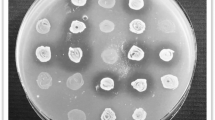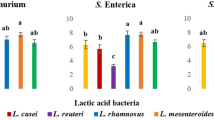Abstract
The use of lactic acid bacteria (LAB) and probiotic cultures in the breeding of animals such as poultry and swine are quite common. It is known that those strains can produce bacteriocins when grown in pure culture. However, the production of bacteriocin using co-culture of microorganisms has not been much studied so far. The present study contributes with innovation in this area by embracing the production of bacteriocin-like inhibitory substances (BLIS) by a newly isolated strain of Enterococcus faecium 135. Additionally, the co-cultivation of this strain with Ligilactobacillus salivarius and Limosilactobacillus reuteri was also investigated. The antimicrobial activity of the produced BLIS was evaluated against Listeria monocytogenes, Listeria innocua, Salmonella enterica, and Salmonella enterica serovar Typhimurium using two methods: turbidimetric and agar diffusion. In addition, the presence of enterocin genes was also evaluated. The BLIS produced showed a bacteriostatic effect against the bio-indicator strains, and the highest antimicrobial activities expressed by arbitrary units per mL (AU/mL) were obtained against L. monocytogenes in monoculture (12,800 AU/mL), followed by the co-culture of E. faecium with Limosilactobacillus reuteri (400 AU/mL). After concentration with ammonium sulfate, the antimicrobial activity raised to 25,600 AU/mL. Assays to determine the proteinaceous nature of the BLIS showed susceptibility to trypsin and antimicrobial activity until 90 °C. Finally, analysis of the presence of structural genes of enterocins revealed that four enterocin genes were present in E. faecium 135. These results suggest that BLIS produced by E. faecium 135 has potential to be a bacteriocin and, after purification, could potentially be used as an antimicrobial agent in animal breeding.


Similar content being viewed by others
Data availability
All data generated or analyzed during this study are included in this published article.
References
European Food Safety Authority, European Centre for Disease Prevention (2016) The European Union summary report on antimicrobial resistance in zoonotic and indicator bacteria from humans, animals and food in 2014. EFSA J 14(2): 4380. https://doi.org/10.2903/j.efsa.2016.4380
García-Sánchez L, Melero B, Jaime I, Hänninen ML, Rossi M, Rovira J (2017) Campylobacter jejuni survival in a poultry processing plant environment. Food Microbiol 65:185–192. https://doi.org/10.1016/j.fm.2017.02.009
Crotta M, Georgiev M, Guitian J (2017) Quantitative risk assessment of Campylobacter in broiler chickens – assessing interventions to reduce the level of contamination at the end of the rearing period. Food Control 75:29–39. https://doi.org/10.1016/j.foodcont.2016.12.024
Lakicevic B, Nastasijevic I (2017) Listeria monocytogenes in retail establishments: contamination routes and control strategies. Food Rev Int 33:247–269. https://doi.org/10.1080/87559129.2016.1175017
Johnson TJ, Shank JM, Johnson JG (2017) Current and potential treatments for reducing Campylobacter colonization in animal hosts and disease in humans. Front Microbiol 8:1–14. https://doi.org/10.3389/fmicb.2017.00487
Strompfová V, Kubašová I, Ščerbová J (2019) Oral administration of bacteriocin-producing and non-producingstrains of Enterococcus faecium in dogs. Appl Microbiol Biotechnol 103:4953–4965. https://doi.org/10.1007/s00253-019-09847-3
Soltani S, Hammami R, Cotter PD (2021) Bacteriocins as a new generation of antimicrobials: toxicity aspects and regulations. FEMS Microbiol Rev 45:1–24. https://doi.org/10.1093/femsre/fuaa039
Ramchandran L, Shah NP (2010) Characterization of functional, biochemical and textural properties of synbiotic low-fat yogurts during refrigerated storage. LWT - Food Sci Technol 43:819–827. https://doi.org/10.1016/j.lwt.2010.01.012
Khan H, Flint S, Yu P-L (2010) Enterocins in food preservation. Int J Food Microbiol 141:1–10. https://doi.org/10.1016/j.ijfoodmicro.2010.03.005
Mitsuoka T (2014) Development of functional foods. Biosci Microbiota, Food Heal 33:117–128. https://doi.org/10.12938/bmfh.33.117
Zheng J, Wittouck S, Salvetti E, Franz CMAP, Harris HMB, Mattarelli P, O’Toole PW, Pot B, Vandamme P, Walter J, Watanabe K, Wuyts S, Felis GE, Gänzle MG, Lebeer S (2020) A taxonomic note on the genus Lactobacillus: description of 23 novel genera, emended description of the genus Lactobacillus Beijerinck 1901, and union of Lactobacillaceae and Leuconostocaceae. Int J Syst Evol Microbiol 70:2782–2858. https://doi.org/10.1099/ijsem.0.004107
Gillor O, Etzion A, Riley MA (2008) The dual role of bacteriocins as anti- and probiotics. Appl Microbiol Biotechnol 81:591–606. https://doi.org/10.1007/s00253-008-1726-5
Cotter PD, Hill C, Ross RP (2005) Food microbiology: bacteriocins: developing innate immunity for food. Nat Rev Microbiol 3:777–788. https://doi.org/10.1038/nrmicro1273
Messaoudi S, Manai M, Kergourlay G, Prévost H, Connil N, Chobert J-M, Dousset X (2013) Lactobacillus salivarius: bacteriocin and probiotic activity. Food Microbiol 36:296–304. https://doi.org/10.1016/j.fm.2013.05.010
Suvorov A (2020) What is wrong with enterococcal probiotics? Probiotics Antimicrob Proteins 12:1–4. https://doi.org/10.1007/s12602-020-09633-y
Acedo JZ, Chiorean S, Vederas JC, van Belkum MJ (2018) The expanding structural variety among bacteriocins from Gram-positive bacteria. FEMS Microbiol Rev 42:805–828. https://doi.org/10.1093/femsre/fuy033
Chakchouk-Mtibaa A, Sellem I, Kamoun Y, Smaoui S, Karray-Rebai I, Mellouli L (2018) Safety aspect of Enterococcus faecium FL31 strain and antibacterial mechanism of its hydroxylated bacteriocin BacFL31 against Listeria monocytogenes. Biomed Res Int 2018:1–10. https://doi.org/10.1155/2018/5308464
Qiao X, Du R, Wang Y, Han Y, Zhou Z (2020) Purification, characterization and mode of action of enterocin, a novel bacteriocin produced by Enterococcus faecium TJUQ1. Int J Biol Macromol 144:151–159. https://doi.org/10.1016/j.ijbiomac.2019.12.090
Montiel R, Martín-Cabrejas I, Langa S, El Aouad N, Arqués JL, Reyes F, Medina M (2014) Antimicrobial activity of reuterin produced by Lactobacillus reuteri on Listeria monocytogenes in cold-smoked salmon. Food Microbiol 44:1–5. https://doi.org/10.1016/j.fm.2014.05.006
Liu C, Liu Y, Liao W, Wen Z, Chen S (2004) Simultaneous production of nisin and lactic acid from cheese whey: optimization of fermentation conditions through statistically based experimental designs. Appl Biochem Biotechnol - Part A Enzym Eng Biotechnol 114:627–638. https://doi.org/10.1385/ABAB:114:1-3:627
Foulquié Moreno MR, Rea MC, Cogan TM, De Vuyst L (2003) Applicability of a bacteriocin-producing Enterococcus faecium as a co-culture in Cheddar cheese manufacture. Int J Food Microbiol 81:73–84. https://doi.org/10.1016/S0168-1605(02)00167-8
Maldonado A, Ruiz-Barba JL, Jiménez-Diaaz R (2004) Production of plantaricin NC8 by Lactobacillus plantarum NC8 is induced in the presence of different types of gram-positive bacteria. Arch Microbiol 181:8–16. https://doi.org/10.1007/s00203-003-0606-8
Domínguez-Manzano J, Jiménez-Díaz R (2013) Suppression of bacteriocin production in mixed-species cultures of lactic acid bacteria. Food Control 30:474–479. https://doi.org/10.1016/j.foodcont.2012.09.014
Chanos P, Mygind T (2016) Co-culture-inducible bacteriocin production in lactic acid bacteria. Appl Microbiol Biotechnol 100:4297–4308. https://doi.org/10.1007/s00253-016-7486-8
Rojobezares B, Saenz Y, Navarro L, Zarazaga M, Ruizlarrea F, Torres C (2007) Coculture-inducible bacteriocin activity of Lactobacillus plantarum strain J23 isolated from grape must. Food Microbiol 24:482–491. https://doi.org/10.1016/j.fm.2006.09.003
Kos B, Beganović J, Jurašić L, Švadumović M, Leboš Pavunc A, Uroić K, Šušković J (2011) Coculture-inducible bacteriocin biosynthesis of different probiotic strains by dairy starter culture Lactococcus lactis. Mljekarstvo 61:273–282
Gutiérrez-Cortés C, Suarez H, Buitrago G, Nero LA, Todorov SD (2018) Enhanced bacteriocin production by Pediococcus pentosaceus 147 in co-culture with Lactobacillus plantarum LE27 on cheese whey broth. Front Microbiol 9:1–12. https://doi.org/10.3389/fmicb.2018.02952
Cabo ML, Murado MA, Gonzalez MP, Pastoriza L (1999) A method for bacteriocin quantification. J Appl Microbiol 87:907–914. https://doi.org/10.1046/j.1365-2672.1999.00942.x
Todorov SD, Dicks LMT (2006) Screening for bacteriocin-producing lactic acid bacteria from boza, a traditional cereal beverage from Bulgaria. Process Biochem 41:11–19. https://doi.org/10.1016/j.procbio.2005.01.026
Jackson CR, Fedorka-Cray PJ, Barrett JB (2004) Use of a genus- and species-specific multiplex PCR for identification of enterococci. J Clin Microbiol 42:3558–3565. https://doi.org/10.1128/JCM.42.8.3558-3565.2004
Kariyama R, Mitsuhata R, Chow JW, Clewell DB, Kumon H (2000) Simple and reliable multiplex PCR assay for surveillance isolates of vancomycin-resistant enterococci. J Clin Microbiol 38:3092–3095. https://doi.org/10.1128/jcm.38.8.3092-3095.2000
De Vuyst L (2003) Screening for enterocins and detection of hemolysin and vancomycin resistance in enterococci of different origins. Int J Food Microbiol 84:299–318. https://doi.org/10.1016/S0168-1605(02)00425-7
Henning C, Gautam D, Muriana P (2015) Identification of multiple bacteriocins in Enterococcus spp. using an enterococcus-specific bacteriocin PCR array. Microorganisms 3:1–16. https://doi.org/10.3390/microorganisms3010001
Özdemir GB, Oryaşin E, Biyik HH, Özteber M, Bozdoǧan B (2011) Phenotypic and genotypic characterization of bacteriocins in enterococcal isolates of different sources. Indian J Microbiol 51:182–187. https://doi.org/10.1007/s12088-011-0143-0
Martín M, Gutiérrez J, Criado R, Herranz C, Cintas LM, Hernández PE (2006) Genes encoding bacteriocins and their expression and potential virulence factors of enterococci isolated from wood pigeons (Columba palumbus). J Food Prot 69:520–531. https://doi.org/10.4315/0362-028X-69.3.520
Belgacem ZB, Abriouel H, Omar NB, Lucas R, Martínez-Canamero M, Gálvez A, Manai M (2010) Antimicrobial activity, safety aspects, and some technological properties of bacteriocinogenic Enterococcus faecium from artisanal Tunisian fermented meat. Food Control 21:462–470. https://doi.org/10.1016/j.foodcont.2009.07.007
Almeida T, Brandaão A, MuñOz-Atienza E, Gonçalves A, Torres C, Igrejas G, Hernández PE, Herranz C, Cintas LM, Poeta P (2011) Identification of bacteriocin genes in enterococci isolated from game animals and saltwater fish. J Food Prot 74:1252–1260. https://doi.org/10.4315/0362-028X.JFP-11-016
Lauková A, Guba P, Nemcová R, Vasilková Z (2003) Reduction of Salmonella in gnotobiotic Japanese quails caused by the enterocin A-producing EK13 strain of Enterococcus faecium. Vet Res Commun 27:275–280. https://doi.org/10.1023/A:1024027923824
Martínez PV, López AS, Omar NB, Abriouel H, López RL, Valdivia E, Belloso OM, Gálvez A (2008) Enhanced bactericidal effect of enterocin AS-48 in combination with high-intensity pulsed-electric field treatment against Salmonella enterica in apple juice. Int J Food Microbiol 128:244–249. https://doi.org/10.1016/j.ijfoodmicro.2008.08.014
Baños A, García-López JD, Núñez C, Martínez-Bueno M, Maqueda M, Valdivia E (2016) Biocontrol of Listeria monocytogenes in fish by enterocin AS-48 and Listeria lytic bacteriophage P100. LWT - Food Sci Technol 66:672–677. https://doi.org/10.1016/j.lwt.2015.11.025
Messaoudi S, Kergourlay G, Dalgalarrondo M, Choiset Y, Ferchichi M, Prévost H, Pilet MF, Chobert JM, Manai M, Dousset X (2012) Purification and characterization of a new bacteriocin active against Campylobacter produced by Lactobacillus salivarius SMXD51. Food Microbiol 32:129–134. https://doi.org/10.1016/j.fm.2012.05.002
Todorov SD, Furtado DN, Saad SMI, De Melo Franco BDG (2011) Bacteriocin production and resistance to drugs are advantageous features for Lactobacillus acidophilus La-14, a potential probiotic strain. New Microbiol 34:357–370
Mastromatteo M, Lucera A, Sinigaglia M, Corbo MR (2010) Synergic antimicrobial activity of Lysozyme, Nisin, and EDTA against Listeria monocytogenes in Ostrich Meat Patties. J Food Sci 75 (7): M422-M429 . https://doi.org/10.1111/j.1750-3841.2010.01732.x
Khan A, Vu KD, Riedl B, Lacroix M (2015) Optimization of the antimicrobial activity of nisin, Na-EDTA and pH against gram-negative and gram-positive bacteria. LWT - Food Sci Technol 61:124–129. https://doi.org/10.1016/j.lwt.2014.11.035
Nes IF, Diep DB, Håvarstein LS, Brurberg MB, Eijsink V, Holo H (1996) Biosynthesis of bacteriocins in lactic acid bacteria. Antonie Van Leeuwenhoek 70:113–128. https://doi.org/10.1007/BF00395929
Diep DB, Håvarstein LS, Nes IF (1995) A bacteriocin-like peptide induces bacteriocin synthesis in Lactobacillus plantarum C11. Mol Microbiol 18:631–639. https://doi.org/10.1111/j.1365-2958.1995.mmi_18040631.x
Giraffa G, Carminati D, Tarelli GT (1995) Inhibition of Listeria innocua in milk by bacteriocin-producing Enterococcus faecium 7C5. J Food Prot 58:621–623. https://doi.org/10.4315/0362-028X-58.6.621
Nes IF, Diep DB, Holo H (2007) Bacteriocin diversity in Streptococcus and Enterococcus. J Bacteriol 189:1189–1198. https://doi.org/10.1128/JB.01254-06
Franz CMAP, Van Belkum MJ, Holzapfel WH, Abriouel H, Gálvez A (2007) Diversity of enterococcal bacteriocins and their grouping in a new classification scheme. FEMS Microbiol Rev 31:293–310. https://doi.org/10.1111/j.1574-6976.2007.00064.x
Liu X, Vederas JC, Whittal RM, Zheng J, Stiles ME, Carlson D, Franz CMAP, McMullen LM, van Belkum MJ (2011) Identification of an N-terminal formylated, two-peptide bacteriocin from Enterococcus faecalis 710C. J Agric Food Chem 59:5602–5608. https://doi.org/10.1021/jf104751v
Liu G, Griffiths MW, Wu P, Wang H, Zhang X, Li P (2011) Enterococcus faecium LM-2, a multi-bacteriocinogenic strain naturally occurring in “Byaslag”, a traditional cheese of Inner Mongolia in China. Food Control 22:283–289. https://doi.org/10.1016/j.foodcont.2010.07.023
Acknowledgements
The authors also thank the Oswaldo Cruz Foundation (Fiocruz) for donating the Salmonella enterica serovar Typhimurium and Listeria innocua strains.
Funding
This work was supported by São Paulo Research Foundation—FAPESP (grant #2018/25511–1), by the Coordenação de Aperfeiçoamento de Pessoal de Nível Superior—Brazil (CAPES)—Finance Code 001, and by the National Council for Scientific and Technological Development – CNPq. Prof. Solange I. Mussatto acknowledges the support from the Novo Nordisk Foundation, Denmark (grant number NNF20SA0066233).
Author information
Authors and Affiliations
Contributions
Anna Carolina Meireles Piazentin performed all the experiments and analyses of the data and wrote the first draft of this manuscript; Carlos Miguel Nóbrega Mendonça performed the microbial cultivation; Marisol Vallejo carried out the molecular identification of E. faecium; Solange I. Mussatto helped in the preparation of the manuscript and was responsible for the revision and correction of the text; and Ricardo Pinheiro de Souza Oliveira provided the equipment, reagents, and space to perform all the experimental analyses, and also helped in the revision and correction of the text.
Corresponding author
Ethics declarations
Ethical approval
Not applicable.
Conflict of interest
The authors declare no competing interests.
Additional information
Responsible Editor: Luis Augusto Nero
Publisher's note
Springer Nature remains neutral with regard to jurisdictional claims in published maps and institutional affiliations.
Rights and permissions
About this article
Cite this article
Piazentin, A.C.M., Mendonça, C.M.N., Vallejo, M. et al. Bacteriocin-like inhibitory substances production by Enterococcus faecium 135 in co-culture with Ligilactobacillus salivarius and Limosilactobacillus reuteri. Braz J Microbiol 53, 131–141 (2022). https://doi.org/10.1007/s42770-021-00661-6
Received:
Accepted:
Published:
Issue Date:
DOI: https://doi.org/10.1007/s42770-021-00661-6




